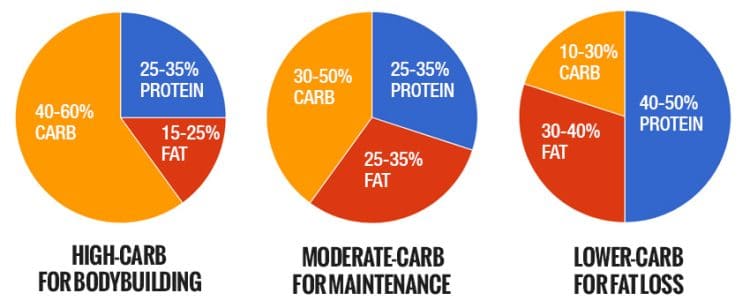A lot of diets, be they for cutting or bulking, specify that you should eat a set number of calories. For example, they may say to eat 1,500 for weight loss or 3,500 calories for muscle gain.
Unfortunately, such generalized calorie intake recommendations fail to acknowledge that everybody’s calorie needs are different and can even vary from day to day.
Take the guesswork out of determining your ideal calorie intake with our easy-to-use Actual Metabolic Rate (AMR) calculator.
Actual Metabolic Rate Calculator
What is AMC?
There are lots of abbreviations used during discussions about metabolic rate, which is the number of calories your body burns per day. That’s because several components add up to make your daily calorie expenditure. These include:
BMR
This is your Basal Metabolic Rate, which is the number of calories your body burns per day at rest and in a fasted state. BMR is the amount of energy needed for essential physiological functions like breathing, brain activity, and maintaining your core temperature. BMR represents about 50-65% of your total daily energy expenditure.
Level Up Your Fitness: Join our 💪 strong community in Fitness Volt Newsletter. Get daily inspiration, expert-backed workouts, nutrition tips, the latest in strength sports, and the support you need to reach your goals. Subscribe for free!
TEA
TEA stands for the Thermal Effect of Activity and is the number of calories you burn during exercise. This number is hugely variable and can range from zero to over 1,000 depending on how hard, long, and often you work out.
NEAT
This acronym stands for Non-Exercise Activity Thermogenics. NEAT refers to physical activity that isn’t structured exercise, such as walking, gardening, playing with your kids, taking out the trash, etc.
TEA and NEAT Combine to represent about 30-50% of your total daily energy expenditure.
TEF
TEF stands for the Thermal Effect of Food. While the food you eat contains calories, ingesting, digesting, utilizing, and eliminating it also uses energy. TEF varies from food to food, depending on its macronutrient composition.
Fat has a TEF of about 3-5%, while protein is closer to 15-20%. Carbohydrates fall somewhere in between these two values. TEF represents about 10% of your total daily energy expenditure.
And now you can add AMC to your list of metabolism acronyms!
AMC or actual metabolic rate is your basal metabolic rate (BMR) plus your TEA (thermal effect of activity), including an adjustment for non-exercise thermal activity (NEAT) and the thermal effect of food (TEF).
So, in simple terms, your AMC is an estimate of the number of calories you burn during an average day.
How is AMR Calculated?
Our AMR calculator uses two equations to determine your Active Metabolic Rate. The two equations are:
1. Mifflin St. Jeor Equation
- Men: 10 x weight (kg) + 6.25 x height (cm) – 5 x age (y) + 5
- Women: 10 x weight (kg) + 6.25 x height (cm) – 5 x age (y) – 161
2. Revised Harris-Benedict Equation
- Men: (13.397m + 4.799h – 5.677a) + 88.362
- Women: (9.247m + 3.098h – 4.330a) + 447.593
(m is mass in kg, h is height in cm, a is age in years)
Each of these calculations reveals your BMR or Basal Metabolic Rate. Once BMR is determined, the calculator then estimates your AMR by taking your physical activity level into account:
- Lightly active – exercise 1-2 times per week
- Moderately active – exercise 2-3 times per week
- Heavily active – exercise 3-4 times per week
- Extra-heavy – exercise 5-7 times per week
The more active you are, the higher your AMR will be, which is why exercise is vital for weight loss, fat burning, and long-term weight control.
How To Use The AMR Calculator
Our AMR (Actual Metabolic Rate) calculator is straightforward to use. Just follow these step-by-step instructions, and you’ll have your results in seconds…
Level Up Your Fitness: Join our 💪 strong community in Fitness Volt Newsletter. Get daily inspiration, expert-backed workouts, nutrition tips, the latest in strength sports, and the support you need to reach your goals. Subscribe for free!
- Choose between imperial units (pounds, feet, and inches) or metric units (kilograms, meters, and centimeters)
- Specify your gender
- Enter your weight in pounds or kilograms
- Enter your height in feet/meters and inches/centimeters
- Specify your current activity level
- Hit “Calculate“
Your results should appear almost instantly. If any boxes are outlined in red, you have either entered an unworkable value or failed to provide the information required. Go back and enter all the correct details, and the calculator will work just fine.
What Do the Results Mean?
Your Actual Metabolic Rate or AMR is the number of calories your body uses per day, including during exercise. It’s calculated by multiplying your Basal Metabolic Rate by an appropriate physical activity factor.
For example, if your AMR is 2,200 calories, that’s the amount of energy your body uses per day. Consuming 2,200 calories should mean that your body weight remains relatively constant, as your energy expenditure is the same as your energy intake, and you won’t gain or lose body fat.
Factors that affect your AMR include:
- Activity levels – as AMR includes calories burned during exercise, the more physical activity, the higher the value will be. Conversely, your AMR will be lower if you do less physical activity.
- Age – AMR tends to decline with age, often because of decreases in muscle mass. Lost muscle is one of the factors that lead to middle-age weight gain.
- Diet – protein has a higher thermic effect than carbs and fats. So, if you eat a lot of protein, your metabolism will be higher.
- Genetics – some people have a higher AMR than others and are said to have a “fast metabolism.”
- Muscle mass – the more muscular you are, the more calories your body uses at rest. Gaining muscle is one of the best ways to increase your AMR.
- Pregnancy – being pregnant causes an increase in AMR as more energy is required by the growing fetus. Menopause also affects AMR and can cause it to increase or decrease depending on hormonal changes.
- Supplements and drugs – stimulants can cause AMR to increase, including caffeine. Other medications can cause the AMR to fall, such as some sedatives.
- Weather – cold weather tends to increase AMR as your body will have to use more energy to maintain its core temperature. However, being very hot also burns more calories, as your body needs to expend energy to try and keep you cool.
How to Use Your AMR?
Once you know your AMR, you can use it to determine how many calories you need to eat per day to reach your weight and body composition goals.
To lose weight, burn fat, and get leaner, you must consume 500 calories below your AMR. This creates a negative energy balance or calorie deficit. The shortfall in energy will give your body no choice but to start burning fat for fuel. A 500 calorie per day deficit should lead to a weight loss of 1-2 pounds per week.
To gain weight and build muscle, you must raise your intake by about 500 calories above your AMR. This creates a positive energy balance or calorie surplus. These additional calories are used for workout recovery and muscle growth.
However, it’s important to understand that these are general guidelines only. As accurate as the AMC calculator is, it’s only an estimate. You may need to raise or lower your calorie intake depending on your progress. Remember, several factors determine your AMR which are not accounted for in the AMC calculator, such as muscle mass, genetics, and protein intake.
Tracking Calories and Macros
Now you know your Actual Metabolic Rate (AMR), you need to make sure your food intake matches your caloric needs, i.e.:
- 500 less than your AMR to LOSE weight and burn fat
- Equal to your AMR to MAINTAIN your current weight
- 500 more than your AMR to GAIN weight and build muscle
Hitting these numbers means you need to start tracking and analyzing your food intake.
The easiest way to do this is with an app. There are lots to choose from, many of which are free. Even the ones you have to pay for are very cheap.
The app will contain a vast database of foods. All you need to do is enter what and how much you have eaten, and it will calculate the number of calories as well as grams of protein, carbohydrates, and fats.
Alternatively, you can use an online food database and record your calories in a notebook.
While calorie counting can be laborious, it’s the only way to ensure that your calorie intake matches your body composition goal. Consuming too many or too few calories will undermine your progress.
The next thing you need to do is choose the best macronutrient ratio for your goals. The macronutrients are protein, carbohydrate, and fat.
Each macro serves a different function, and it can be helpful to adjust your macro ratio to make your diet even more effective.
For example, if you do a lot of intense exercise, you may need more carbs for energy. However, if you want to burn fat while preserving muscle, more protein can help. So, match your macro ratio to your goal.
Macro ratio options include:

Actual Metabolic Rate Calculator FAQs
1. What is AMR?
AMR is an acronym for Actual Metabolic Rate. Your AMR is the number of calories your body uses each day, including for exercise, general physical activity, and digestion. It’s similar to your Active Metabolic Rate and your Total Daily Energy Expenditure.
2. How many calories should I eat to lose weight and burn fat
Create a calorie deficit by subtracting 500 calories from your AMR calculator result. So, if your AMR is 2,600 calories, you should eat 2,100 per day to lose between 1-2 pounds of fat per week. If you aren’t losing weight, you may need to reduce your calorie intake further.
3. How many calories should I eat to gain weight and build muscle?
Create a calorie surplus by adding 500 calories to your AMR calculator result. So, if your AMR is 2,500 calories, you should eat 3,000. Expect to gain 1-2 pounds per month of muscle, plus an additional 1-2 pounds of fat. If you aren’t gaining weight, you may need to increase your calorie intake further.
4. How accurate is the Actual Metabolic Rate Calculator
This calculator uses two well-regarded equations for estimating AMR; Mifflin St. Jeor and Revised Harris-Benedict. Studies suggest that these equations are accurate to within 10% (2). Because of this, you should monitor your progress and adjust your calorie intake based on your individual results.
5. How often should I recalculate my AMR?
Your AMR is determined by several factors, including your weight, age, and activity levels. As such, you should recalculate your AMR whenever anything changes, i.e., you gain or lose weight or celebrate a birthday.
You may also want to calculate your AMR for rest days, selecting the light activity option. That way, you can reduce your calorie intake to reflect that you won’t be exercising.
AMR – Wrapping Up
There is very little benefit to tracking your diet if you don’t know how many calories you need to eat per day. Even if you are eating healthily, you could still sabotage your progress if you consume too much or too little food.
Estimate your ideal calorie intake with our Actual Metabolic Rate calculator. It’s easy to use, takes mere seconds, and could save you months of wasted effort if your calorie intake doesn’t match your body composition goals.
References:
1- PubMed: A high-protein diet for reducing body fat: mechanisms and possible caveats https://www.ncbi.nlm.nih.gov/pmc/articles/PMC4258944/
2- PubMed: Comparison of predictive equations for resting metabolic rate in healthy non-obese and obese adults: a systematic review https://pubmed.ncbi.nlm.nih.gov/15883556/






